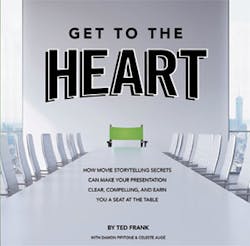What it's about: Communication is vital to every business but too often the process involves a lot of effort for very little return. Executives are overwhelmed with meetings and boring presentations. The result, says author Ted Frank, is they "find it harder and harder to retain anything." Get to the Heart (Backstories Studio, 2016, 222 pages, $28.95) shows how to use moviemaking story techniques to create PowerPoint presentations or short films that are memorable and impactful.
3 Steps to More Effective Presentations
1. Make it simple. If the audience for your presentation can only remember a few things, says Frank, then it is vital to choose the most important points, present them in a visual, memorable way and, equally important, get rid of everything else. In most movies, Frank explains, there are just three key scenes. Screenwriters develop those scenes and then build the rest of the movie around them. That's the opposite of many company presentations, where PowerPoint slides are packed with information.
"We're in the weeds because we fall in love with all the information we have," Frank tells IndustryWeek. "Sometimes it's because we think it is really important and sometimes it's because we worked really hard to get it."
2. Make it real. Context is what helps us relate to a theme or to data. "To find the context in anything, find the characters," Frank writes in Get to the Heart. "They can be the people or things your data point is depicting or the people who can jump on the opportunity your data presents." Giving an example, he says, is a way to tell a short story. Putting a picture to that example, he says, puts everyone on the same page. It brings clarity, makes it quicker to understand and more memorable.
3. Make it powerful. While not every presentation is a big deal, Frank says, you likely face a few high-stakes situations a year where you need to knock it out of the park. That's when you need to invoke emotion. Emotion, he writes, is "the magic potion that moves us to decision and action." Rather than present data on incrementally increasing margin, Frank says, think about creating a sense of urgency to beat a competitor or to be the most efficient factory in the company. "What is that pride moment that you can point people to?" he asks. He calls this the "desire point." Franks says the presentation should then end with the next steps to take so you build confidence in your audience. "You create an arc of we have to do this, we want to do this and we can do this," he says.
For the big presentations: Practice, practice, practice. Frank contrasts speakers who are looking at their computer screen or reading their notes in front of an audience with more experienced speakers who have memorized their speech and are looking their audience in the eyes. The latter, he writes, are "so much more engaging and the room absolutely blooms with energy."






